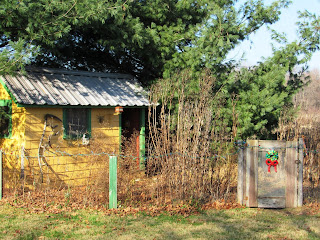At the beginning of January, I pulled out our collected seed from the refrigerator to organize by germination requirements.
Many seeds will germinate readily in the spring after planting, but many possess dormancies that must be broken to allow for germination. Usually this means the seed needs a certain period of cold, moist, freezing and thawing, which is called stratification. These dormancies help protect the seed from rotting, too early germination, etc.
To do this indoors, I moistened the paper sack containing the seed requiring this type of stratification, sealed it in a plastic bag and labeled the bag to note seed type and how long the necessary stratification period. You can place the seed in moist sand, put it in a plastic bag and put it in the refrigerator (many people do) , but the seed was already in a paper sack and the sand frozen so I tried this to keep it simple. Maybe next year we will try something else....experimenting is good.
Acid treatment also helps if you have seed with such a tough seed coat it must weather for several years to crack it open. This helps protect the seed against possible years of inclement growing conditions by allowing a super long period of dormancy...some seed is still viable after hundreds of years, Google it and be as amazed as we are!
For this type of treatment, we used battery acid, which contains a percentage of sulphuric acid. You can see my PPE in the right side of the photo because acid is not something to be careless with. I started as a chemistry major in college before I switched to biology so I've spent a lot of time in labs. My one summer working in an environmental lab in Fort Wayne, IN - acid bathing various O rings (newbie/grunt task), testing water samples, working under hoods and running the atomic spectrometer was very cool, but its greatest purpose showed me I craved - even required more time outdoors, hence my switch. Even as a biology major, I spent so many lovely weather days in a lab, working diligently, but sneaking regular glances out at the beautiful North Carolina sun. I felt like a caged animal that just needed out. The plant and ecology classes that took me outside made my heart, mind and soul happy and I can't think of anything better than happiness, really.
Thanks to a super awesome female high school chemistry teacher, I still find all this more technical science stuff interesting.
Since we don't have a lab here, I use outside fresh air to help keep the work safe.
Look at these beautiful Staghorn Sumac seeds! They are completely edible (very citrusy) and make a nice tea, pre-acid treatment of course. I soaked bladdernut, rose, sumac and KY coffeetree seeds for a number of hours before rinsing them thoroughly and placing them in moist paper sack in a plastic bag. Some may require longer periods than I gave them, but we won't know until the growing season.
Good note taking is key to organization and doing things better next time. Here's our list of the seeds we have, the stratifications required and when I should get on with things. Since we don't own a greenhouse, we work according to Mother Nature and when she says it's ok to plant in Ohio. I worked all our dates around the average frost-free date for our area, which is right around May 15.
And, voila! All the seed is organized and back in the refrigerator until its noted time for stratification or planting.















































